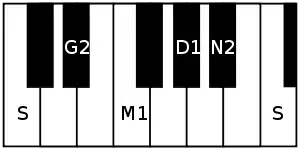Hindolam
Hindōḷaṃ is a rāgam in Carnatic music (musical scale of South Indian classical music). It is an audava rāgam (5 notes in arohana and avarohana) as it does not have all the seven swaras (musical notes). Hindolam is not the same as the Hindustani Hindol. The equivalent of Hindolam in Hindustani music is Malkauns[1] (or Malkosh[2]).
| Arohanam | S G₂ M₁ D₁ N₂ Ṡ |
|---|---|
| Avarohanam | Ṡ N₂ D₁ M₁ G₂ S |
| Carnatic music |
|---|
 |
| Concepts |
| Compositions |
| Instruments |
|
It is known to be a rāgam that is generally beautiful and soothing to listen to. Being symmetrical in its ascending and descending scales, it lends itself very well to improvisation and is therefore popular at concerts.
Structure and Lakshana

Hindōḷaṃ is a symmetric rāgam that does not contain rishabham and panchamam. It is a pentatonic scale (audava-audava rāgam[1][2] in Carnatic music classification—audava means 'of 5'). Since pentatonic scales can be found in other world music such as Chinese music, shades of Mohanam and Hindōḷaṃ can sometimes be traced in Chinese and east Asian music. Its ārohaṇa-avarohaṇa structure (ascending and descending scale) is as follows (see swaras in Carnatic music for details on below notation and terms):
- ārohaṇa : S G₂ M₁ D₁ N₂ Ṡ[lower-alpha 1]
- avarohaṇa : Ṡ N₂ D₁ M₁ G₂ S[lower-alpha 2]
This rāgam uses the swaras sadharana gandharam, shuddha madhyamam, shuddha dhaivatam and kaisiki nishadam. Hindolam is not a melakarta rāgam, since it does not contain all the seven swaras.
Experts in Carnatic music hold differences of opinion on the janaka rāgams (rāgams of origin) that should be attributed to Hindolam. It is widely accepted that the 20th melakarta, Natabhairavi, is the parent rāgam of Hindolam, but some would like to associate it with the 8th melakarta, Hanumatodi.[1][2] It can be derived from both, by dropping the rishabham and panchamam.
Popular Compositions
Sāmajavara gamanā by the maestro Tyagaraja is one of the most popular compositions in Hindolam. Mamavatu śri Sarasvati by Mysore Vasudevachar is another popular composition. Here are some more kritis composed in Hindolam:
- Samajavaragamana, Manasulōni Marmamulu and Gōvardhana Giridhāri by Tyagaraja
- Madhukara Vritti, Yaare Rangana,[3] Avanavana Kayva, by Purandaradasa
- Dasa Dasara Maneya By Kanakadasa
- Guru Purandara Dasare, Uma Kathyayani By Vijaya Dasa
- Hari Sarvothama Vayu Jeevothama By Kamalesha Vittala Dasu
- Gōvardhana Girīśam Smarāmi, Neerajakshi Kamakshi and Saraswati Vidhiyuvathi by Muthuswami Dikshitar
- Padmanabha Pāhi by Swathi Thirunal
- Maa Ramanan, Sāma Gāna lolalane and Nambikettavar by Papanasam Sivan
- Sadanandamayi Chinmayi by Oothukadu Venkata Kavi
- Mamavatu Sri Saraswati by Mysore Vasudevacharya
- Chintayami Jagadamba by Jayachamarajendra Wodeyar
- Dēva Dēvaṃ Bhajē, Konḍalalō Nelakonna, Garuda Gamana, Narayana Ni Namame, Nigama Nigama Nigamandha by Annamacharya
- Ramanakku Mannan Mudi by Arunachala Kavi
- Mal Marugan (varnam) by Thanjavur Shankara Iyer
- Tillana (Dhim na naa tha dhirana) by Balamuralikrishna
Numerous bhajans, stotras, kritis and film music numbers also have been composed in the Hindolam rāgam.
Tamil Film Songs
Non Film Songs
| Song | Language | Album | Year | Composer | Lyricist | Singer | Audio Label |
|---|---|---|---|---|---|---|---|
| Tamil | Lord Muruga T M Sounder Revival | M S Viswanathan | Vaali | T M Soundararajan | |||
| Narudu Gurudani | Telugu | Namo Venkatesaya[4] | 2019 | Mahesh Mahadev | Kaiwara Sri Yogi Nareyana | S. P. Balasubhramanyam, Priyadarshini,
Mahesh Mahadev, Raghuram |
PM Audios |
Kannada Film Songs
| Song | Movie | Year | Composer | Singer |
|---|---|---|---|---|
| Gharani Ghara Gharane | Aptharakshaka | 2010 | Guru Kiran | S. P. Balasubhramanyam |
| Nagisalu Neenu Naguvenu Naanu | Gaali Maathu | 1981 | Rajan–Nagendra | S. Janaki |
| Nanna Neenu Gellalaare | Nee Nanna Gellalaare | 1981 | Rajkumar, S. Janaki | |
| Neenu Neene Illi Naanu Naane | Gadibidi Ganda | 1993 | S. P. Balasubhramanyam | |
| Baanina Anchinda Bande | Shravana Banthu | 1984 | Rajkumar |
Related rāgams
This section covers the theoretical and scientific aspect of this rāgam.
Hindolam's notes when shifted using Graha bhedam, yields 4 other major pentatonic rāgams, namely, Mohanam, Shuddha Saveri, Udayaravichandrika (also known as Shuddha Dhanyasi) and Madhyamavati. Graha bhedam is the step taken in keeping the relative note frequencies same, while shifting the shadjam to the next note in the rāgam. For more details and illustration of this concept refer Graha bhedam on Mohanam.
Scale similarities
- Saramati has an asymmetric scale, with the ascending scale of Natabhairavi, while the descending scale is same as Hindolam. Its ārohaṇa-avarohaṇa structure is S R2 G2 M1 P D1 N2 S : S N2 D1 M1 G2 S
Notes
- Alternate notations:
- Hindustani: S G̱ M Ḏ Ṉ Ṡ
- Western: C E♭ F A♭ B♭ C
- Alternate notations:
- Hindustani: Ṡ Ṉ Ḏ M G̱ S
- Western: C B♭ A♭ F E♭ C
References
- Ragas in Carnatic music by Dr. S. Bhagyalekshmy, Pub. 1990, CBH Publications
- Raganidhi by P. Subba Rao, Pub. 1964, The Music Academy of Madras
- "Rama Mantrava". YouTube. Archived from the original on 21 December 2021.
- "Namo Venkatesaya - Single by Mahesh Mahadev, Priyadarshini & S. P. Balasubrahmanyam". Apple Music. Retrieved 5 September 2020.